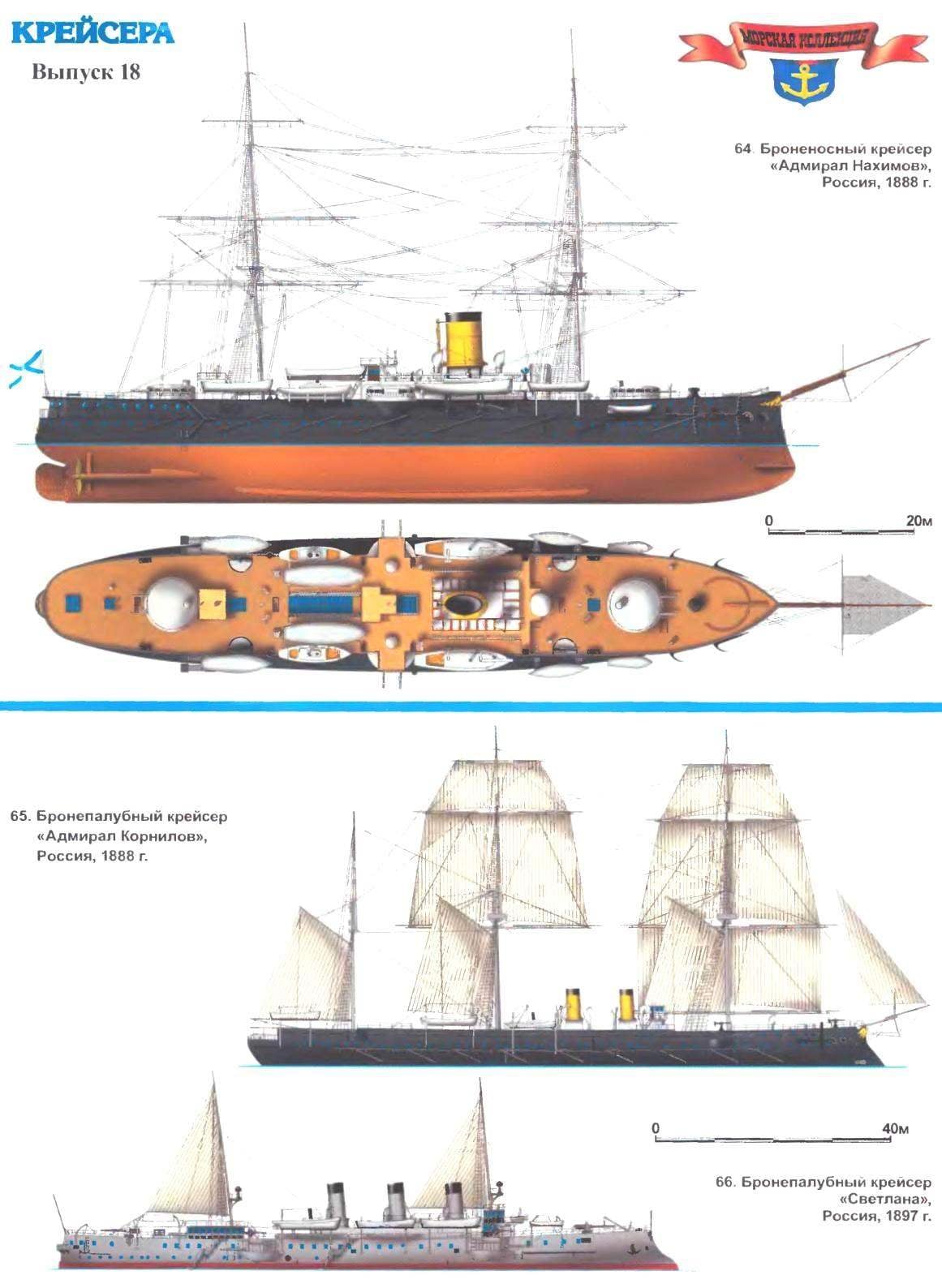 “Time of troubles” was the 80-ies of the XIX century for the Russian Navy in General and cruising in particular. In addition to the lungs paranapanema clippers (which was already, in essence, mostly training ships), genuine domestic development remained armored frigates of the “Dmitry Donskoy” and “Vladimir Monomakh”. However, very good for the time of laying they are with their sailing mast location and battery of artillery was somewhat aloof from the world trends in the development of cruisers and gradually became obsolete. The main sea powers one after the other tended to build armored units. Some new armored cruiser was gradually lost huge “sailing” mast with a web of cable and wires, getting in return a contemporary energy and gun installation.
“Time of troubles” was the 80-ies of the XIX century for the Russian Navy in General and cruising in particular. In addition to the lungs paranapanema clippers (which was already, in essence, mostly training ships), genuine domestic development remained armored frigates of the “Dmitry Donskoy” and “Vladimir Monomakh”. However, very good for the time of laying they are with their sailing mast location and battery of artillery was somewhat aloof from the world trends in the development of cruisers and gradually became obsolete. The main sea powers one after the other tended to build armored units. Some new armored cruiser was gradually lost huge “sailing” mast with a web of cable and wires, getting in return a contemporary energy and gun installation.
In such circumstances, the leadership of the Russian fleet chose to use the existing foreign experience in this field. But a problem: prevented the strained relations with England, and the United States and Germany have not yet gained the proper authority. But always remained a traditional ally of France, also heavily updating its fleet, and is the “generator of ideas” no less than “mistress of the seas”, though very interested in foreign orders, allows you to work on their projects for other people’s money.
We have already talked about how noticeable impression in naval circles produced the first armored cruiser E. Bertana, “Sfax”, and the even more formidable “Cecile” and “Tar”. “Sfax” as once entered in system, when the Russian government received a tempting offer to build a “cruiser special new type with high speed and greater cruising range” with the armor deck.
In fact, the proposed project was a slightly modified cruiser “Cecil”. Russian “leaders” really wanted to get a perspective, in their opinion, the ship. And firm of “La Loire” were so sure that the order is already in her pocket, she started work before signing the official contract. •
However, domestic experts assessed the possibility of future “French” is very modest. So, S. O. Makarov said that the project, instead of specific technical tools and solutions contains only General phrases and ideas. Was especially concerned about the very weak security status. Actually, itself, a flat armored deck slopes located below the waterline eased the engines and boilers from direct contact, but did not prevent the flow of water into the body through the holes. Moreover, while maintaining the water tightness of the armored deck, the water flooded over her, creating a dangerous situation from the point of view of preservation of stability. Therefore, “the guardian ship of morality”—the Naval technical Committee (MTK)—insisted on the device of a double bottom and triple Board. From French offered to arrange alongside a favorite cofferdam filled with fibre of coconut (it was believed that when a hole at the waterline swollen weight will close it and will not penetrate to the great masses of water).
Meanwhile, measures have clearly positive from the point of view of protection, have led to substantial overload, causing the ship gleaning some of their design of 18 knots. Besides the 4-year period of construction of almost devalued the achievements of the French and Russian improvements. Although well-armed “Admiral Kornilov” turned out to be a good acquisition. In 1905 it was even suggested to include in the 3rd Pacific squadron rear Admiral N. And.Nebogatova. But the cruiser, who by that time training, did not have time to rearm and prepare for a distant voyage.
Somewhat disappointed in the virtues of the armored variant of the Russian marine “masters of doom” turned to a more serious ship with armor belt. Actually, Russia has successfully built armored frigates of their own projects. However, the cruiser with on-Board battery abroad has gradually gone out of fashion. Therefore, the MTC wanted to join the global experience and to develop the project “cruiser-battleship”, is relatively small, but is able not only to act alone against enemy communications, and, if necessary, to stand in line of battle.
As a prototype of the admirals chose the British “Imperius” who made a good impression qualities such as high speed and high survivability of artillery, located in separate towers—a rare decision for cruisers to stage the French “Dupuy de Scrap” and his descendants. The initial draft of the future “Admiral Nakhimov” in General, much like “Englishman” with his four open Barberini installations, arranged in a diamond shape: one each in the bow and stern, and in the middle of the hull on both sides. The choice of the main fire proved to be quite easy. Originally intended to outshine the proud Britons by installing a 280-mm artillery. But the guns of the sample in 1877 by that time already outdated, and nothing new is expected. Then, the MTC agreed to 229-mm guns. But they were met with significant complications. Designers several times changed the size and shape of the Barbet, because it could not create a new machine with a short rollback, which would in this setup be accommodated. In the end, there was a very good solution: single desyatidyuymovy replaced paired jasminewebcam. While almost half increased weight of broadside. However, the ship finally ceased to be a “real battleship”.

64. Armored cruiser “Admiral Nakhimov”, Russia, 1888
Built at the Baltic shipyard in St. Petersburg. Displacement 8520 tons, waterline length of 101.5 m, the width to 18.59 m, draft of 8.38 m. Capacity twin-shaft steam engine installation “compound” 9000 HP, speed 17 KTS. Booking (armor “compound”): belt at the waterline 254— 152 mm, 203 mm barbettes -178, submission 76 mm, deck 51 -76 mm, cutting 152 mm Armament: eight 203-mm and ten 152-mm (18 a barrel length of 35 calibers) and four 87-mm gun (barrel length 24 gauge), six 47-mm and four 37-mm small-caliber turret guns, three 380-mm torpedo tubes. In 1899, the new boilers have been installed and removed a 47-mm and 37-mm guns. Sunk the team during the battle of Tsushima on may 15, 1905.
Armored cruiser “Admiral Kornilov”, Russia, 1888
Built at the shipyard of “La Seine” in Saint-Nazaire (France). Displacement 5860 t, length of maximum 112,16 m, width of 14.83 m, draft of 7.76 m. Capacity twin-shaft steam engine triple expansion installation of 6000 HP, speed of 17.6 KTS. Booking: deck 25 — 60 mm, cutting 75 mm Armament: sixteen 152-mm guns (barrel length of 35 calibers), six 47-mm and ten 37-mm small-caliber rapid-fire guns, six 380-mm torpedo tubes. In 1904-1905 artillery replaced with ten 152-mm rapid-fire guns Kane (barrel length 45 calibres). Excluded from the list in 1911.
Armored cruiser “Svetlana”, Moscow, Russia, 1897
Built at the shipyard “forges Chantiers e” in Le Havre (France). The displacement of 3865 tons, waterline length 101,0 m, beam 13.0 m, draught 5,7 m. Capacity twin-shaft steam engine triple expansion installation 8500 HP, speed without boost 20 knots with boost of 21.5 KTS. Booking: deck
25 mm (on the bevel 50 mm), the protection cylinder machines 120 mm, shields guns 25 mm, cutting 100 mm. Armament: six 152 mm rapid-fire guns, Kane, and ten 47-mm small-caliber, four 380-mm torpedo tubes. In 1899 sailed in Arctic waters (Barents sea). Flooded team after the battle, may 15, 1905
In General, the Russian version of “Imperiosa” in no way inferior to their prototype, and in many ways surpasses it. So, for the first time in Russia used electric lighting and anti-torpedo nets. However, during the construction of are not able to avoid the main problem of the vast majority of warships at the time—considerable congestion, amounting to almost 500 so in Fairness it should be noted that the builders ‘British’ scored even more, exceeding the design displacement of 900 tons.
Protection of “Nakhimov” made a very strong impression. Armor belt length 45 m of steel-iron armour “compound” covered the most important spaces in the middle of the hull—mechanical installation and cellars, also had a substantial thickness of, quite befitting the battleship. On top of it was covered by a flat armored deck of a thickness of 51 mm. But the tip, too, were not forgotten: they were protected by armor deck with bevels thickness of 76 mm, which corresponded to the normal armored cruiser. Virtually unprotected was only six-inch guns, covered only by a double casing wall (37 mm).
Admirals-“marsoleta” still insisted on retaining a completely modern ship sailing arms. However, fore and aft barbettes prevented to preserve the traditional three-masted “fregats” snap—the third mast just didn’t fit. So I decided, as on the prototype, put a snap-in brig (but still useless). As he “Imperius”, “Nakhimov” barely crawled under sail, even with a decent wind, and together with the machine won no more than node speed.
The process of getting rid of the “canvas” turned out to be long and complex. It began with a collision with another pseudoparasitism, “Memory of Azov” (which we’ll explain below) in 1893, when the ship lost its long bowsprit. After moving to the far East with “Nakhimov” have removed almost all steggy, and finally he lost a sailing mast during the modernization of the 1898-1899 years. Light signal masts with mast and one ray cruiser acquired the complete graceful look.
Strong and original warship was popular from the first days of life. Not even quite ready “Nakhimov” has already participated in important state action. In the summer of 1887 he was made an honorary escort for the Royal yacht, having together with her the trip to Copenhagen. At the transition of the Baltic sea revealed significant drawback of the cruiser: when a strong emotion its abundantly flush-deck hull took the water with his nose. Speed sometimes had to reduce down to 3-4 knots—minimum speed, at which the ship obeyed the helm. After a campaign Sea, the Ministry has even proposed to suspend the construction, temporarily remove the nose gun mount and form in front of the forecastle. However, the delay in entry into operation valuable combat units seemed less desirable, especially because, according to the calculations, the alteration would cause a deterioration in the protection of artillery. In the end, “Nakhimov” entered the service with minimal changes from the final draft.
At the end of 1888 he was sent to a point, become a truly “hot” for the Russian Navy over the next 20 years—to the far East. All his long life with a few exceptions “Nakhimov” was spent either there or in the repair and upgrades in Kronstadt. Finished his long career cruiser in the 2-nd Pacific squadron. Due to the lack of battleships Z. P. Rozhdestvensky and put it in line of battle. Trailing the 2nd armored detachment “Admiral Nakhimov” was eighth in the long Wake column of the main forces. However, because of the constant failure of the main ships he sometimes appeared even in the fourth Russian convoy, and it accounted for almost 30 hits of shells of calibre from 76 to 305 mm. On the cruiser was destroyed, add-ins, will be sidelined for a few guns, and the crew lost 76 men killed and wounded. But the old ship was still combat-ready and lived up to the saving of the dark.
Completely destroyed the ship his own light. Bringing up the rear the remnants of the Russian squadron, vengeance luminous floodlights cruiser immediately attracted the attention of Japanese destroyers and about 10 o’clock in the evening received a torpedo hit in the bow of the starboard side. The water quickly filled the space, dynamos, and began to spread through the ship. She couldn’t stop fully closed on combat alert doors in bulkheads—the ancient rubber pads were useless. However, the “Nakhimov” continued to fight for his life. To ease the pressure on the rusted over 17 years of service watertight bulkhead, the ship bravely went astern. Long. The nose is so plunged into the water, it became clear that the veteran has even released, not hours and minutes. The commander of the cruiser had to come to the unfortunate island of Tsushima, came to the rescue and in the morning the Japanese had to rescue our sailors from the water.
Despite the undoubtedly outstanding qualities and potential of “Admiral Nakhimov”, he, like armored “French” Kornilov, remained in the form of a single sample.
MTC continued and expensive experiments. Now their keynote was the desire to develop a “Russian type” armored cruisers. Since its last representatives were the “Vladimir Monomakh” and “Dmitry Donskoy”, and chosen as a prototype for a new ship, called the “Memory of Azov”. Artillery and weapons of the original fully repeating those of the “don”, but in the course of design and construction was followed by numerous changes, both small and significant. Guns got armor shields, increased protection of the decks and armor belt with the help of engineers did a clean hakerskie exercises: initially reduced from full to 55 m, and then returned to its previous state—from the bow to the sternpost. In an attempt to somehow keep in the overloading constructors have reduced the width of the belt to 1.7—1.8 m into a narrow “loincloth”. The result was a strange cruiser, the thickness of the plates is inferior to “Nakhimov” and had a smaller area of protection than “Monomah”. And all attempts to curb overloading failed; it reached 800 tons—so much that before going to the far East from the cruiser took off the whole amount of minutes, a couple of 6-Dujmovic and many small equipment. But even in this state, the test was able to develop only 16.8 per node instead of design 18.
“Memory of Azov” was lucky: he passed the tragedy and shame of Port Arthur and Tsushima.
Anyone have a sequel, please write in the comments.
Recommend to read
 BRAND? NO NEGATIVES
BRAND? NO NEGATIVES
So the photographers happened: please films the attention and care, and the negative — no. First Packed in frames, cellophane, and plastic bags, and the second often just stored in a... MOTORCYCLE BACKPACK
MOTORCYCLE BACKPACK
This small trailer was designed and manufactured when our family received a plot of land for gardening in the suburbs of Cheboksary. Immediately there is a need to transport various...
 “Time of troubles” was the 80-ies of the XIX century for the Russian Navy in General and cruising in particular. In addition to the lungs paranapanema clippers (which was already, in essence, mostly training ships), genuine domestic development remained armored frigates of the “Dmitry Donskoy” and “Vladimir Monomakh”. However, very good for the time of laying they are with their sailing mast location and battery of artillery was somewhat aloof from the world trends in the development of cruisers and gradually became obsolete. The main sea powers one after the other tended to build armored units. Some new armored cruiser was gradually lost huge “sailing” mast with a web of cable and wires, getting in return a contemporary energy and gun installation.
“Time of troubles” was the 80-ies of the XIX century for the Russian Navy in General and cruising in particular. In addition to the lungs paranapanema clippers (which was already, in essence, mostly training ships), genuine domestic development remained armored frigates of the “Dmitry Donskoy” and “Vladimir Monomakh”. However, very good for the time of laying they are with their sailing mast location and battery of artillery was somewhat aloof from the world trends in the development of cruisers and gradually became obsolete. The main sea powers one after the other tended to build armored units. Some new armored cruiser was gradually lost huge “sailing” mast with a web of cable and wires, getting in return a contemporary energy and gun installation.



